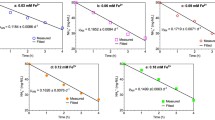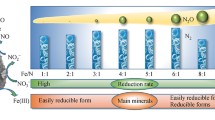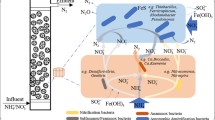Abstract
Fe(II)-mediated autotrophic denitrification with four different microbial cultures under different pH and EDTA/Fe(II) conditions was investigated in batch bioassays. Initially, the highest nitrate removal (72%) was achieved with an activated sludge inoculum. The use of pure cultures of Pseudogulbenkiania strain 2002 and Thiobacillus denitrificans resulted in a 55 and 52% nitrate removal, respectively. No denitrification was observed for a mixed culture dominated by Thiobacillus thioparus and T. denitrificans. A longer enrichment on Fe(II) and the supplementation of thiosulfate as additional electron donor were needed to stimulate the denitrifying activity of the Thiobacillus-mixed culture. A second subculture on Fe(II) as sole electron donor resulted in higher denitrification efficiencies for all microbial cultures. In particular, nitrate removal reached up to 84% with a specific nitrate removal rate of 1.160 mM·(g VSS·day)−1 in the bioassays seeded with the Thiobacillus-mixed culture. All cultures were favored by decreasing the EDTA/Fe(II) molar ratio from 2.0 to 0.5. The most significant denitrification enhancement was observed for the Pseudogulbenkiania species, indicating a lower tolerance to EDTA. The two pure cultures effectively maintained denitrification at pH 7.0 and were more sensitive to a pH decrease. Conversely, the optimal pH was 6.0 for the Thiobacillus-mixed and activated sludge cultures.




Similar content being viewed by others
References
Ahoranta SH, Kokko ME, Papirio S, Özkaya B, Puhakka JA (2016) Arsenic removal from acidic solutions with biogenic ferric precipitates. J Ηazardous Mater 306:124–132
American Public Health Association (APHA) (1992) Standard methods for the examination of water and waste water, 18th edn. APHA, AWWA, WPCF
Ashok V, Hait S (2015) Remediation of nitrate-contaminated water by solid-phase denitrification process—a review. Environ Sci Pollut Res 22:8075–8093
Bhandari VM, Sorokhaibam LG, Ranade VV (2016) Industrial wastewater treatment for fertilizer industry—a case study. Desalin Water Treat 57:27934–27944
Blöthe M, Roden EE (2009) Composition and activity of an autotrophic Fe (II)-oxidizing, nitrate-reducing enrichment culture. Appl Environ Microbiol 75:6937–6940
Chakraborty A, Picardal F (2013) Induction of nitrate-dependent Fe (II) oxidation by Fe (II) in Dechloromonas sp. strain UWNR4 and Acidovorax sp. strain 2AN. Appl Environ Microbiol 79:748–752
Di Capua F, Ahoranta SH, Papirio S, Lens PNL, Esposito G (2016) Impacts of sulfur source and temperature on sulfur-driven denitrification by pure and mixed cultures of Thiobacillus. Process Biochem 51:1576–1584
Di Palma L, Ferrantelli P, Merli C, Biancifiori F (2003) Recovery of EDTA and metal precipitation from soil flushing solutions. J Hazard Mater 103:153–168
Hedrich S, Schlömann M, Johnson DB (2011) The iron-oxidizing proteobacteria. Microbiology 157:1551–1564
Hohmann C, Winkler E, Morin G, Kappler A (2009) Anaerobic Fe(II)-oxidizing bacteria show As resistance and immobilize As during Fe(III) mineral precipitation. Environ Sci Technol 44:94–101
Ji Z, Chen Y (2010) Using sludge fermentation liquid to improve wastewater short-cut nitrification-denitrification and denitrifying phosphorus removal via nitrite. Environ Sci Technol 44:8957–8963
Johnson DB, Kanao T, Hedrich S (2012) Redox transformations of iron at extremely low pH: fundamental and applied aspects. Front Microbiol 3:1–13
Juang R-S, Wang S-W (2000) Metal recovery and EDTA recycling from simulated washing effluents of metal-contaminated soils. Water Res 34:3795–3803
Kanaparthi D, Pommerenke B, Casper P, Dumont MG (2013) Chemolithotrophic nitrate-dependent Fe (II)-oxidizing nature of actinobacterial subdivision lineage TM3. The ISME Journal 7:1582–1594
Kanaparthi D, Conrad R (2015) Role of humic substances in promoting autotrophic growth in nitrate-dependent iron-oxidizing bacteria. Syst Appl Microbiol 38:184–188
Kelly DP, Wood AP (2000) Confirmation of Thiobacillus denitrificans as a species of the genus Thiobacillus, in the beta-subclass of the Proteobacteria, with strain NCIMB 9548 as the type strain. Int J Syst Evol Microbiol 50:547–550
Kiskira K, Papirio S, van Hullebusch ED, Esposito G (2017) Fe(II)-mediated autotrophic denitrification: a new bioprocess for iron bioprecipitation/biorecovery and simultaneous treatment of nitrate-containing wastewaters. Int Biodeterior Biodegrad 119:631–648
Klueglein N, Picardal F, Zedda M, Zwiener C, Kappler A (2015) Oxidation of Fe (II)-EDTA by nitrite and by two nitrate-reducing Fe (II)-oxidizing Acidovorax strains. Geobiology 13:198–207
Kumaraswamy R, Sjollema K, Kuenen G, Van Loosdrecht M, Muyzer G (2006) Nitrate-dependent [Fe (II) EDTA] 2− oxidation by Paracoccus ferrooxidans sp. nov., isolated from a denitrifying bioreactor. Syst Appl Microbiol 29:276–286
Manconi I, Carucci A, Lens P (2007) Combined removal of sulfur compounds and nitrate by autotrophic denitrification in bioaugmented activated sludge system. Biotechnol Bioeng 98:551–560
Muehe EM, Gerhardt S, Schink B, Kappler A (2009) Ecophysiology and the energetic benefit of mixotrophic Fe (II) oxidation by various strains of nitratereducing bacteria. FEMS Microbiol Ecol 70:335–343
Nielsen JL, Nielsen PH (1998) Microbial nitrate-dependent oxidation of ferrous iron in activated sludge. Environ Sci Technol 32:3556–3561
Oshiki M, Ishii S, Yoshida K, Fujii N, Ishiguro M, Satoh H, Okabe S (2013) Nitrate-dependent ferrous iron oxidation by anaerobic ammonium oxidation (anammox) bacteria. Appl Environ Microbiol 79:4087–4093
Oviedo C, Rodríguez J (2003) EDTA: the chelating agent under environmental scrutiny. Quim Nova 26:901–905
Papirio S, Ylinen A, Zou G, Peltola M, Esposito G, Puhakka JA (2014) Fluidized-bed denitrification for mine waters. Part I: low pH and temperature operation. Biodegradation 25:425–435
Park JY, Yoo YJ (2009) Biological nitrate removal in industrial wastewater treatment: which electron donor we can choose. Appl Microbiol Biotechnol 82:415–429
Qambrani NA, Jung SH, Ok YS, Kim YS, Oh SE (2013) Nitrate-contaminated groundwater remediation by combined autotrophic and heterotrophic denitrification for sulfate and pH control: batch tests. Environ Sci Pollut Res 20:9084–9091
Robertson, L. A. and Kuenen, J. G. (2006) The genus Thiobacillus, In: The prokaryotes. Springer, pp 812–827
Sorensen J (1987) Nitrate reduction in marine sediment: pathways and interactions with iron and sulfur cycling. Geomicrobiol J 5:401–421
Straub K, Benz M, Schink B, Widdel F (1996) Anaerobic, nitrate-dependent microbial oxidation of ferrous iron. Appl Environ Microbiol 62:1458–1460
Straub KL, Schönhuber WA, Buchholz-Cleven BEE, Schink B (2004) Diversity of ferrous iron-oxidizing, nitrate-reducing bacteria and their involvement in oxygen-independent iron cycling. Geomicrobiol J 21:371–378
Tago K, Ishii S, Nishizawa T, Otsuka S, Senoo K (2011) Phylogenetic and functional diversity of denitrifying bacteria isolated from various rice paddy and rice-soybean rotation fields. Microbes Environ 26:30–35
Viers, J. H., Liptzin, D., Rosenstock, T. S., Jensen, W. B., Hollander, A. D., McNally, A. and King, A. M. (2012) Nitrogen sources and loading to groundwater, In Technical Report 2, Assessing Nitrate in California’s Drinking Water. Center for Watershed Sciences, University of California Davis, CA
Wang D, Wang Y, Liu Y, Ngo HH, Lian Y, Zhao J, Chen F, Yang Q, Zeng G, Li X (2017) Is denitrifying anaerobic methane oxidation-centered technologies a solution for the sustainable operation of wastewater treatment plants? Bioresour Technol 234:456–465
Weber KA, Achenbach LA, Coates JD (2006a) Microorganisms pumping iron: anaerobic microbial iron oxidation and reduction. Nat Rev Microbiol 4:752–764
Weber KA, Pollock J, Cole KA, O’Connor SM, Achenbach LA, Coates JD (2006b) Anaerobic nitrate-dependent iron(II) bio-oxidation by a novel lithoautotrophic betaproteobacterium, strain 2002. Appl Environ Microbiol 72:686–694
Weber KA, Hedrick DB, Peacock AD, Thrash JC, White DC, Achenbach LA, Coates JD (2009) Physiological and taxonomic description of the novel autotrophic, metal oxidizing bacterium, Pseudogulbenkiania sp. strain 2002. Appl Microbiol Biotechnol 83:555–565
Zaitsev G, Mettänen T, Langwaldt J (2008) Removal of ammonium and nitrate from cold inorganic mine water by fixed-bed biofilm reactors. Miner Eng 21:10–15
Zeng QR, Sauve S, Allen HE, Hendershot WH (2005) Recycling EDTA solutions used to remediate metal-polluted soils. Environ Pollut 133:225–231
Zhang M, Zheng P, Li W, Wang R, Ding S, Abbas G (2015) Performance of nitrate-dependent anaerobic ferrous oxidizing (NAFO) process: a novel prospective technology for autotrophic denitrification. Bioresour Technol 179:543–548
Zou G, Papirio S, Ylinen A, Di Capua F, Lakaniemi AM, Puhakka JA (2014) Fluidized-bed denitrification for mine waters. Part II: effects of Ni and Co. Biodegradation 25:417–423
Zou G, Papirio S, van Hullebusch ED, Puhakka JA (2015) Fluidized-bed denitrification of mining water tolerates high nickel concentrations. Bioresour Technol 179:284–290
Zou G, Papirio S, Lakaniemi AM, Ahoranta SH, Puhakka JA (2016) High rate autotrophic denitrification in fluidized-bed biofilm reactors. Chem Eng J 284:1287–1294
Acknowledgments
The study was carried out in the framework of the Erasmus Mundus Joint Doctorate ETeCoS3 (Environmental Technologies for Contaminated Solids, Soils, and Sediments) funded by the European Commission under the grant agreement FPA no. 2010-0009. Kyriaki Kiskira was supported by a grant from the Italian Ministry of Education, University and Research (MIUR).
Author information
Authors and Affiliations
Corresponding author
Additional information
Responsible editor: Gerald Thouand
Rights and permissions
About this article
Cite this article
Kiskira, K., Papirio, S., van Hullebusch, E.D. et al. Influence of pH, EDTA/Fe(II) ratio, and microbial culture on Fe(II)-mediated autotrophic denitrification. Environ Sci Pollut Res 24, 21323–21333 (2017). https://doi.org/10.1007/s11356-017-9736-4
Received:
Accepted:
Published:
Issue Date:
DOI: https://doi.org/10.1007/s11356-017-9736-4




